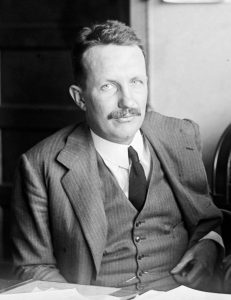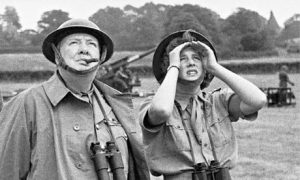Finest Hour 181
The Queen’s Royal Hussars Today
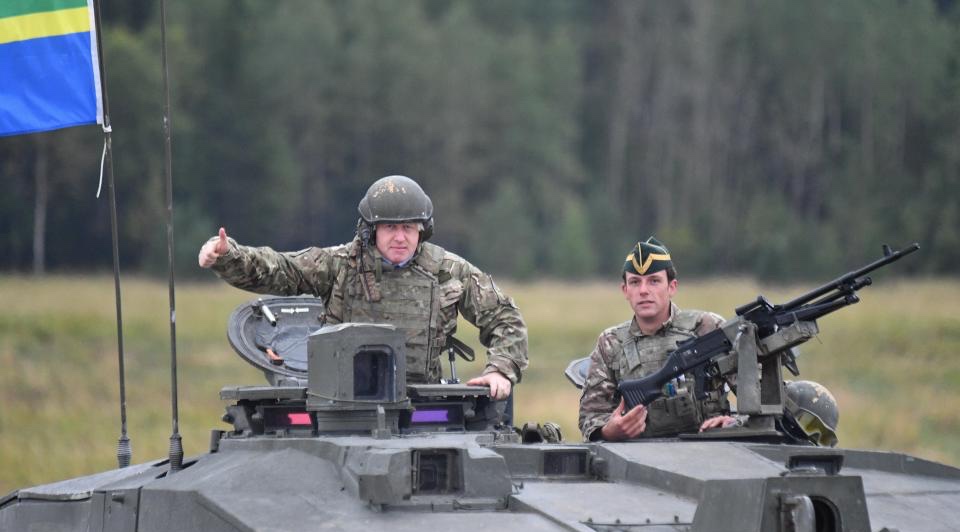
Author with Boris Johnson
October 28, 2018
Finest Hour 181, Summer 2018
Page 34
By Capt. B. F. J. Spink
B. F. J. Spink is a captain in The Queen’s Royal Hussars. He represented the regiment at the 2016 International Churchill Conference in Washington, D.C.
Many men have spent their formative years in the 4th Queen’s Own Hussars, but very few have gone on to be as interlinked with the Regiment as Winston Churchill. Since his appointment in 1941 as the Colonel of the Regiment, he has dominated Regimental identity. This influence continued in The Queen’s Royal Irish Hussars, as Churchill was asked to continue as the Colonel of the Regiment following the 4th Queen’s Own Hussars’ amalgamation with the 8th Kings Royal Irish Hussars. Even today, fifty-three years after Churchill’s death and twenty-five years after the amalgamation of The Queen’s Royal Irish Hussars with The Queen’s Own Hussars to form The Queen’s Royal Hussars, Churchill’s ethos is still fundamental to what it means to be a soldier in The Queen’s Royal Hussars. He is such an intrinsic part of the fabric of the Regiment that we call ourselves “Churchill’s Own.”
Today The Queen’s Royal Hussars are one of three tank regiments in the British Army, equipped with the Challenger 2 main battle tank. As part of the 3rd (UK) Division, the United Kingdom’s war fighting division, the Regiment’s focus is developing readiness and inter-operability with our NATO allies.
In 2017 the Regiment had one squadron form part of NATO’s Very High Readiness Joint Task Force (L
and), a multi-national battlegroup prepared for rapid reaction to a situation anywhere in the world within five days. At the same time another squadron was included in the Vanguard Armoured Infantry Brigade, the British Army’s lead armoured formation. The third squadron was deployed to Estonia under NATO’s enhanced Forward Presence designed to reassure the Baltic States and deter Russian aggression.
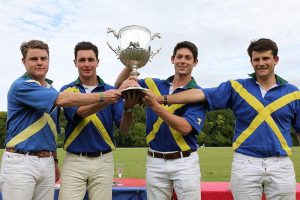
Central to our preparation are our annual tank ranges, which ensure we are ready to deploy and effectively engage the enemy. During this three-week period, the troops compete for the Churchill Cup—donated by Churchill himself and first contested in 1957—which is awarded to the best troop at mounted gunnery. Naturally this is a highly competitive event that sees the winning crews recognised in front of the entire Regiment. Sport is also an important part of Regimental life, and, when not training to win on operations, we train to win on the pitch. Football and rugby remain the two most popular sports, but the Regiment also maintains its polo heritage. We currently have the strongest team in the British Army, and we recently won the Captains and Subalterns Polo Tournament—one of the oldest cups in sport.
This summer The Queen’s Royal Hussars deployed two of their squadrons along with their Regimental Headquarters to Canada for a month-long exercise, playing enemy against another armoured unit on the Canadian prairie. The Regiment’s third squadron has been deployed to the United Kingdom for the year, providing armoured expertise to train fledgling tank commanders. This year has also seen The Queen’s Royal Hussars represent the UK as the first team to take part in the Strong Europe Tank Challenge, promoting ever tighter relationships across Europe—a very Churchillian ideal. The team, assembled from across the Regiment, competed against the USA, France, Germany, Sweden, Austria, Poland, and Ukraine. We came fourth, but we have plans to win it in future years.
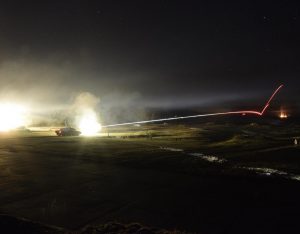
The British Army constantly works to promote leadership throughout its ranks, and this July The Queen’s Royal Hussars held a month of leadership lectures focused on the “Greatest Hussar of Them All.” The series will focus on introducing Churchill’s life and achievements to our soldiers and expanding on the concept of Churchillian leadership before putting the same theories into practice through a patrol competition designed around the life of Churchill. We were also extremely fortunate to have Katherine Carter from Chartwell come to Germany to deliver the keynote speech to the Regiment.
Recognising the importance of rehabilitating and conditioning our injured soldiers, the Regiment has created Churchill Troop. This specialist rehabilitation unit aims to remove the stigma of being injured while delivering the appropriate and targeted support our soldiers need to get back to full fitness.
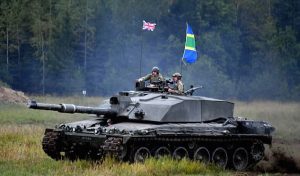
The coming years will see a great deal of activity for The Queen’s Royal Hussars. In 2019 the Regiment will deploy to Canada to be tested on Challenger 2 main battle tanks; this will qualify us to deploy on operations as an armoured battlegroup. On return from Canada, the Regiment will experience one of the largest changes in our recent history: returning to the United Kingdom after more than twenty years based in Germany. The Regiment has been based in North Rhine-Westphalia continuously since 1998, with our antecedent regiments’ history in Germany dating back to the Second World War. Next summer, however, we will move to Tidworth Garrison in Wiltshire. Shortly after, we deploy to Estonia as NATO’s enhanced Forward Presence for six months. It will be a great privilege to be the enhanced Forward Presence battlegroup, and it is an excellent opportunity to deploy the Commanding Officers’ tank—aptly known as Churchill. As the Regiment looks to the future, it also keeps one eye on the past. Next summer sees The Queen’s Royal Hussars regimental museum open in Warwick. Based in the heart of the Regiment’s recruiting area, it will hold the lion’s share of our history, including information on the great man himself.
If you would like to know more about The Queen’s Royal Hussars, we can be followed on Twitter: @ChurchillsOwn, Instagram: @Churchills_Own and Facebook: @TheQueensRoyalHussars.
Subscribe
WANT MORE?
Get the Churchill Bulletin delivered to your inbox once a month.

